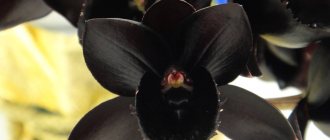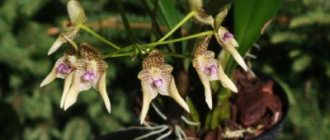Despite the ominous name, not all representatives of the Dracula genus from the Orchid family decorate the world with dark petals. And the second name of this beautiful plant is not at all comparable in meaning to the first. Find out from our article what secret is kept by the history of the appearance of an unusual orchid, as well as everything about its varieties and subspecies.
We will tell you in detail how to properly care for this very demanding exotic flower. By looking at the photographs and receiving step-by-step instructions, you will avoid any problems associated with growing a wonderful epiphyte.
Detailed description
The flower received its ominous name - Dracula (lat. Dracula) thanks to the inflorescence, which in appearance resembles the mouth of a dragon. Also, the plant does not like sunlight , just like the famous vampire.
All orchids of this species are characterized by small stems, soft spongy leaves and a specific flower shape: three sepals fused together, with long narrow projections at the ends. The petals have variegated colors and are often densely covered inside with hairs - trichomes. The large lip is shaped like a mushroom.
Dracula is an epiphytic plant. In nature, it grows on trees, but does not feed from them, but only uses them as a support.
Diseases and pests
Like other Orchids, Dracula is predisposed to specific ailments and the effects of parasites. Ignoring a plant’s poor health can result in its death.
Thrips
The most dangerous insects for epiphytes. An infected plant is difficult to resuscitate even in the early stages. The treatment period with a special drug lasts at least a month, treatment is carried out once a week. The product is sold in any gardening store and, as a rule, has a wide spectrum of action.
Whitefly
It appears mainly in the summer, when the air in the room is dry and the temperature is high. Colonies of larvae appear in the axils of the leaves, and adults fly on the crown, feeding on the sap of the plant. They often settle on other green neighbors on the windowsill, regardless of their type. To treat the stem, spray it with calendula infusion and clean the leaves manually with a cotton swab.
Aphid
It is dangerous not so much because it multiplies quickly and kills the orchid, but because it carries a lot of more serious illnesses: viruses, fungal spores, etc. Dracula needs to be sprayed with soapy water and wiped off the leaves. Insecticides also do a good job of removing these insects.
Fungi and mold
First of all, they appear on the leaves in the form of brown or almost black spots. The main thing is not to confuse them with sunburn. Root rot affects the underground part. The disease is expressed by softening and darkening of the rhizome. All damaged areas should be removed with a sterile instrument, and treatment should be carried out with a fungicide.
The most famous subspecies and their photos
This genus of orchids is divided into three subgenera.
Sodiroa
It is a monospecies subgenus whose flowers are unusually bell-shaped due to fused sepals.
Xenosia (Xenos)
Representatives of this subgenus have a bright color: many purple specks on a yellow background, a small bright yellow lip.
Dracula (Dracula)
This subgenus includes more than 120 species, the most famous of which are:
- Dracula bella (Beautiful Dracula) - large, spectacular flowers of this subspecies reach up to 20 cm in diameter.
- Dracula chimaera (Dracula chimaera) - this species was the first to be discovered by botanists and was named so because of the long narrow tips of the petals, reminiscent of the tails of ancient monsters.
Dracula bella (Beautiful Dracula)
Dracula chimaera (Dracula chimera)
History of origin
The genus Dracula was first described in 1870 by German botanist Heinrich Gustav Reichenbach, based on a plant found by orchid collector Benedict Roel in the Western Cordillera.
The researcher was amazed by the shape of the flower and called it a “chimera.” This flower amazed the researcher with its unusual shape, for which it received the name “chimera”.
Initially, representatives of the genus Dracula were classified with another orchid - Masdevallia, but in 1878, in the light of other finds, the genus was separated. At the end of the 19th century, Dracula was a popular and valuable greenhouse plant in Europe .
Features of plant care at home
Temperature
Dracula requires moderate temperature conditions: no lower than + 13 °C and no higher than + 25 °C with natural daily and seasonal fluctuations.
Lighting
This type of orchid should not be placed in direct sunlight . The ideal location would be partial shade on the north or east side of the apartment.
Watering
The flower should be watered daily with distilled, melted or filtered tap water that does not contain chlorine.
IMPORTANT! Do not allow water to stagnate at the bottom of the container or on the pallet - this will lead to rotting of the roots and death of the plant.
Top dressing
To feed Dracula, use only special formulations intended for orchids . Fertilizers containing salts are harmful to the plant.
Trimming
An orchid should only be trimmed if any parts of it have dried out.
Transfer
This plant does not need to be replanted without good reason . Do this only in the following cases:
- the substrate has become salty or compacted;
- The roots of the plant have grown too much.
Care during the flowering period
No special care is required during the flowering period. It is only important to remove faded buds in time so that new ones can form in their place.
What to do if the buds don't appear?
To stimulate the appearance of flowers, it is necessary to create conditions under which the difference between day and night air temperatures in the room will be within 4–5 °C.
Growing Dracula Orchid
These plants can be cultivated, but they will not grow in climates that are very different from their natural habitats. Unsuitable conditions lead to burn spots, drying out leaf tips and premature flower drop. The greenhouse should be quite cold, it must be equipped with large fans and air conditioners; the maximum daily temperature should not exceed 25 °C.
Lighting: shade, partial shade.
Plants are best grown in wooden baskets or plastic aquatic pots. Containers can be lined with sphagnum moss and filled with Mexifern fiber and topped with a large amount of live sphagnum moss
To keep the moss in good condition, it is important to use only rainwater for watering. Young plants can be planted on Mexifern blocks with a small backing of moss
Many collectors use dried New Zealand sphagnum moss.
The average temperature for most species is about 15 °C. During the warmer seasons, the temperature should not rise above 25 °C.
Relative air humidity is 70-90%.
Dracula "Bat" (Dracula vespertilio). Orchi Benedict's Dracula (Dracula benedictii). OrchiDracula chimaera. Orchi
Reviews
I raise a monkey in moss. I water it with distillate and once a month with a weak fertilizer solution. The most amazing and beautiful flower, but capricious. I placed it on the windowsill on the north side.
I keep it on the eastern balcony, with the windows wide open. When it's hot, I spray the floor. If someone keeps Dracula in the room, be sure to turn on the air conditioning. A windowsill where tree crowns create partial shade is suitable.
Monkey Face is a very fancy and demanding orchid. Those who raised her at home can be proud. Unique and gentle Dracula is a dream for amateurs and professionals.
Feeding, rest period and how to propagate
Caring for the Dracula orchid at home implies the need to feed it with special organic fertilizers. This should be done during the active growing season, regularly, every 3rd watering and 50% of the volume recommended by manufacturers on the packaging. The orchid is watered less often in autumn and winter when it is cool and dark during the daytime - once a month. Excess feeding will have a detrimental effect on the flower.
The orchid does not have a rest period, so you only need to cut off the peduncle when it has dried out. After flowering, the buds form again. When the peduncle is removed, the Monkey Face requires planting in a different soil and care (reduce watering, observe).
Reproduction of a grown monkey occurs only vegetatively. From seeds - in greenhouses. An adult, overgrown mother bush is divided with a disinfected tool. Each part (plot) should consist of 4-5 sprouts. Coat the cuts with charcoal powder or cinnamon. The soil is the same as for adult flowers. Planting takes place in separate pre-prepared pots.
How to water and maintain humidity
Rains, fog, dew - all this is in nature for Dracula. Any changes in climate destroy the plant even in its natural environment. It is difficult to maintain humidity at 70-85% in homes. A humidifier, air conditioner and fan (for air circulation) will help. To prevent fungi, rot and microorganisms from multiplying - ventilation.
Room temperature, soft water is best for watering:
The water must be free of chlorine so as not to burn the leaves (stains will remain). The pot is placed in a tray and watered with a watering can until the soil is completely covered with water. The roots should be saturated with moisture within 20 minutes. Afterwards, the pot is removed from the tray to drain excess water.
Monkey orchid propagation methods
Reproduction is carried out in only one way - by dividing a large mother bush into parts . To do this, the flower is divided into parts with a tool, which must be disinfected, and the cut areas must be treated with charcoal powder.
Dracula orchid reproduces by dividing the mother bush
Each part of the divided bush should have about 5 buds. All parts are placed in separately prepared containers. The composition of the substrate for new plants does not differ from that used for planting adult flowers .
Maintaining Humidity
In the latitudes where the orchid grows in nature, there are short-term rains almost every day, and in the morning there is fog that settles with dew on the leaves. Dracula is used to moisture. Therefore, it is important to make every effort to bring the cultivated plant as close as possible to the microclimate in which it was created.
Try to prepare the room as much as possible for growing your monkey orchid. In addition to maintaining humidity, ventilate the room with the winter garden regularly, since a damp, stuffy room is an ideal environment for the mass reproduction of fungal diseases and bacterial infections that affect plants.
What soil to choose
The Dracula orchid is grown at home in a pot or basket, and the plant is planted in a substrate. Sometimes they practice a growing system without a substrate - on blocks.
Finely chopped coniferous tree bark along with sphagnum moss, charcoal and fern root are suitable as a growing mixture. Acidity level from 5.5 to 6.5 pH.
Natural growing conditions
Most species of Dracula orchid grow on the wooded slopes of the Cordillera mountain range. As a rule, they are located on the trunks of large trees, but do not climb higher than 3 m from the ground.
Stability of conditions is very important for them; changes may not be tolerated: if a tree for some reason (thanks to a person or naturally) falls, then the orchid in most cases dies.
The natural environment surrounding Dracula is characterized by:
• frequent rains, • high air humidity, • low temperatures (it's cool in the mountains), • low levels of lighting (the sun's rays barely break through the leaves).
The emergence of a new genus
As a result, there were so many similar orchids that in 1978 (more than 100 years after the discovery of Chimera), botanist Carlisle Luer isolated them from the genus Masdevallia into a separate genus, which he called Dracula.
The name "dracula" translates as "little dragon". The name Luera was inspired by flowers, which in their appearance are very reminiscent of the face of a small dragon.
And in 1988, Luer, together with Rodrigo Escobar, published the three-volume collection “Treasury of Dracula”, where the names of orchids were presented differently. And Masdevallia Chimera began to be called Dracula Chimera. Other species have changed according to the same principle: Gorgon, Devil, Nosferatu, Vampire, etc.
This three-volume work has become a real bestiary of the orchid kingdom. Moreover, the newly created genus is still being replenished with new species. Their homeland is the moist montane forests of South and Central America, ranging from southern Mexico to Peru.
Subtleties of care - watering, fertilizing
Watering
How often watering should be depends on the temperature. During the warm season, Dracula needs more water, since moisture evaporates faster. The substrate is moistened when it is completely dry.
Tip #1 . For irrigation, it is better to use settled soft water. Ideal if it is rainy.
It is better to water the orchid so that moisture appears in the pan. Then the substrate is completely wetted. If you only moisten the top layer, the roots will stretch upward and dry out quickly.
At the same time, it is necessary to avoid stagnation of water in the pan. After abundant watering, drain off the excess liquid.
To avoid rotting of orchid roots from excess moisture in the substrate, small pebbles or expanded clay are poured into the tray as drainage.
L.I. Konovalets – head. greenhouse of subtropical plants of North and South America of the Botanical Garden of St. Petersburg
In winter, the amount of watering can be reduced. On average, irrigation sessions will be needed once every two weeks. The exception is the conditions for additional lighting and heating of plants.
Photo
Next you can see in the photo what the Dracula orchid looks like:
"Dracula Sodiroa"
"Dracula Xenosia"
"Dracula Dracula"
Botanical description of flowers of the genus Epiphytic
Representatives of the family are low plants with long arrow-shaped leaves of rich green shades. The stems are short, the rhizome is shortened. Most members of this family lack pseudobulbs. Sometimes the leaves take on a spongy structure, partially fulfilling the functions of the missing above-ground tubers, which are responsible for the survival of the plant in extreme conditions.
The most interesting part of the plant is the flower. In different species they differ in shape, color, size, but in general they consist of three sepals, connected at the formation so that they form a cup with the tips of the elongated petals extended outward. These outgrowths are often densely covered with hairs.
Peduncles are single-flowered (in most species), slightly drooping or straight, in some representatives they are directed downward, penetrating through aerial roots. The seeds of the monkey orchid are small, numerous, and spindle-shaped.
Visually, the flowers resemble the face of a monkey or the mouth of a vampire, which is where they got their name - the Dracula orchid.
An epiphytic orchid can bloom at any time of the year, but it all depends on proper care and compliance with the temperature regime.
In nature, orchids are pollinated not only by small insects, but also by certain species of bats and small rodents (shrews), which, you see, is unusual.
In a poorly ventilated room with a stable daytime temperature of +25°C and above, plants shed buds that have not yet opened and do not bloom. This phenomenon occurs frequently. Therefore, we can judge that the Dracula orchid is a rather finicky and demanding plant.
As for their characteristics, such plants react critically to direct sunlight, summer heat, and drying out roots. This must be taken into account when trying to grow an orchid at home.
Knowledge and application of some agrotechnical tips in culture contribute to the flowering of orchids almost all year round. This also applies to multi-flowered plant subspecies.
Prevention
- Changing conditions is difficult for the plant. Therefore, it cannot be rearranged or changed sides.
- The air should be regularly ventilated at high humidity and low temperature.
- Air conditioners and fans will help save the plant from microbial diseases.
- To avoid thrips, it is recommended to spray the orchid with garlic tincture.
- Short-term overdrying can lead to drying out of the flower. The dried Dracula is removed from the soil, dry roots and leaves are removed and placed in a glass of water with the neck submerged. When new roots appear, the flower is placed in the ground.
- When the roots rot, the orchid is removed from the container, the rotten roots are removed, dipped in crushed coal and planted in new soil.
The Dracula Orchid is a demanding, rare and difficult flower to maintain. It will take a lot of effort to grow it. If you carefully follow the rules of caring for it, the plant will delight you with amazing flowers all year round.











